Journal of the NACAA
ISSN 2158-9429
Volume 10, Issue 1 - June, 2017
Carcass Calculator App: A Quick and Effective Way to Determine Carcass Cutability and Quality of Beef, Lamb and Pork Carcasses
- Smith, S. M., Regional Extension Specialist, Washington State University Extension
Busboom, J. R, Extension Meat Specialist, Washington State University Department of Animal Sciences
ABSTRACT
Various complex equations are used to determine carcass merit, such as dressing percentage, yield grade and the cutability of a beef, lamb, or pork carcass. These equations are used by the USDA and throughout the U.S. livestock industry by producers, university faculty, agriculture teachers, carcass graders, buyers, and livestock judges to evaluate carcass merit. Carcass merit and carcass weight are the primary factors used to determine the value of beef cattle, lambs and pigs when marketed on a carcass basis. The WSU Livestock Carcass Grade & Cutability Calculator app was developed to provide evaluators of livestock and carcasses with a quick and easy way to calculate carcass yield grade, dressing percentages, and cutability of beef, pork and lamb carcasses. Individuals can estimate these carcass merit factors from live animal data of beef cattle, lambs and pigs, in addition to calculating actual carcass merit from carcass data.
INTRODUCTION
Various complex equations are used in both live animal and carcass evaluation to estimate or determine the actual carcass merit of beef cattle, lambs and pigs. These equations enable one to determine the expected carcass weight, amount of lean, or expected retail cuts based on a live or carcass basis. These equations are used by the USDA and throughout the U.S. livestock industry by producers, university faculty, agriculture teachers, carcass graders, buyers, judges and others involved in livestock production.
Potential or actual carcass weight and carcass merit are the primary factors used to determine the value of beef cattle, lambs and pigs when marketed as finished animals on a live or carcass basis. However, potential carcass merit is also used to sort and value feeder animals at weaning or sales. Carcass traits are moderately to highly heritable (Utrera and VanVleck, 2004; Mortimer et al., 2014; and Miar et al., 2014). Thus carcass merit in all species can be improved by genetic selection; however nutrition, management and timely marketing of livestock are also important. An understanding of how carcass merit is determined will aid producers, managers and evaluators to make management decisions to improve quality and profitability.
The differences between species and the various factors used within the carcass merit equations cause them to be complex and difficult to recall. Use of a basic calculator can be confusing because algebraic order of operation rules must be followed to ensure accuracy. Most individuals using these equations use a spreadsheet to increase efficiency and accuracy. It is not practical to have a computer available in a barn or carcass cooler to complete calculations. However, according to a survey by Farm Journal Media, 87% of all famers are likely to own a smartphone by 2016 (Potter, 2015). Smartphone and mobile technology allow individuals to have useful decision making aids at their fingertips. To continue providing effective and timely Extension resources for clientele, smartphone apps need to be developed for farming and ranching practices that influence production and profitability (Dvorak et al., 2012).
METHODS
The WSU Livestock Carcass Grade & Cutability Calculator App (Carcass Calculator App) was developed to provide evaluators of livestock and carcasses with a quick and easy way to calculate carcass yield grade, dressing percentages, and cutability of beef, pork and lamb carcasses (Figure 1). Individuals can estimate these carcass merit factors from live animal data of beef cattle, lambs and pigs, in addition to calculating actual carcass merit from carcass data. The Carcass Calculator App not only allows livestock and carcass evaluators to determine important information about animal and carcass merit, but it also allows users to expand their understanding of carcass merit concepts and factors influencing carcass weight and merit.
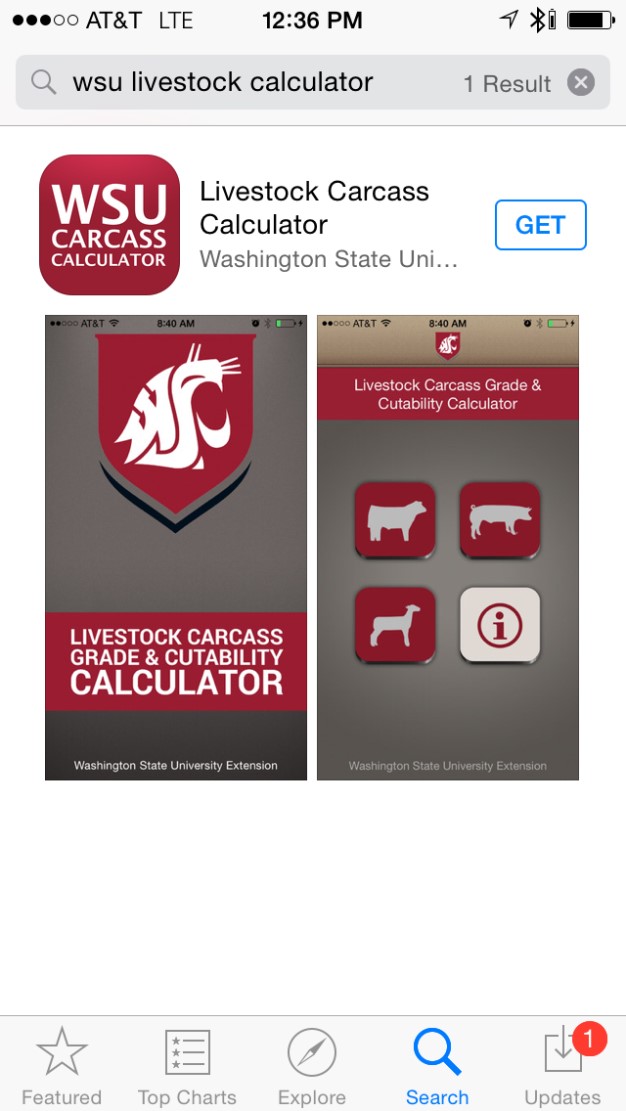
Figure 1. WSU Carcass Calculator App Platform Advertisement
Carcass Calculator Description
The Carcass Calculator App will calculate dressing percentage, estimated yield grade, actual yield grade, and cutability for the three main graded livestock species; beef cattle, lambs and pigs, from estimated live values or measured carcass data (Busboom et al., 2003 a, b and c; Table 1). The app will report calculated yield grade to the nearest hundredth. The app will also report the yield grade per USDA standards, rounding down the calculated yield grade to the nearest whole number between 1 and 5 (Figure 2). Due to differences in packing plant and harvesting procedures, the Carcass Calculator App will correct chilled carcass weight to a hot carcass basis for all three species and will correct pork carcass merit to a skin-on, head-off basis. For beef cattle, the app also has an information tab about USDA quality grades. Users can review pictures of USDA marbling degrees along with a summary of the degrees of marbling required for “A” maturity beef carcasses to receive various USDA grades (Boggs et al., 2006).
Table 1. Carcass Calculator App Calculations
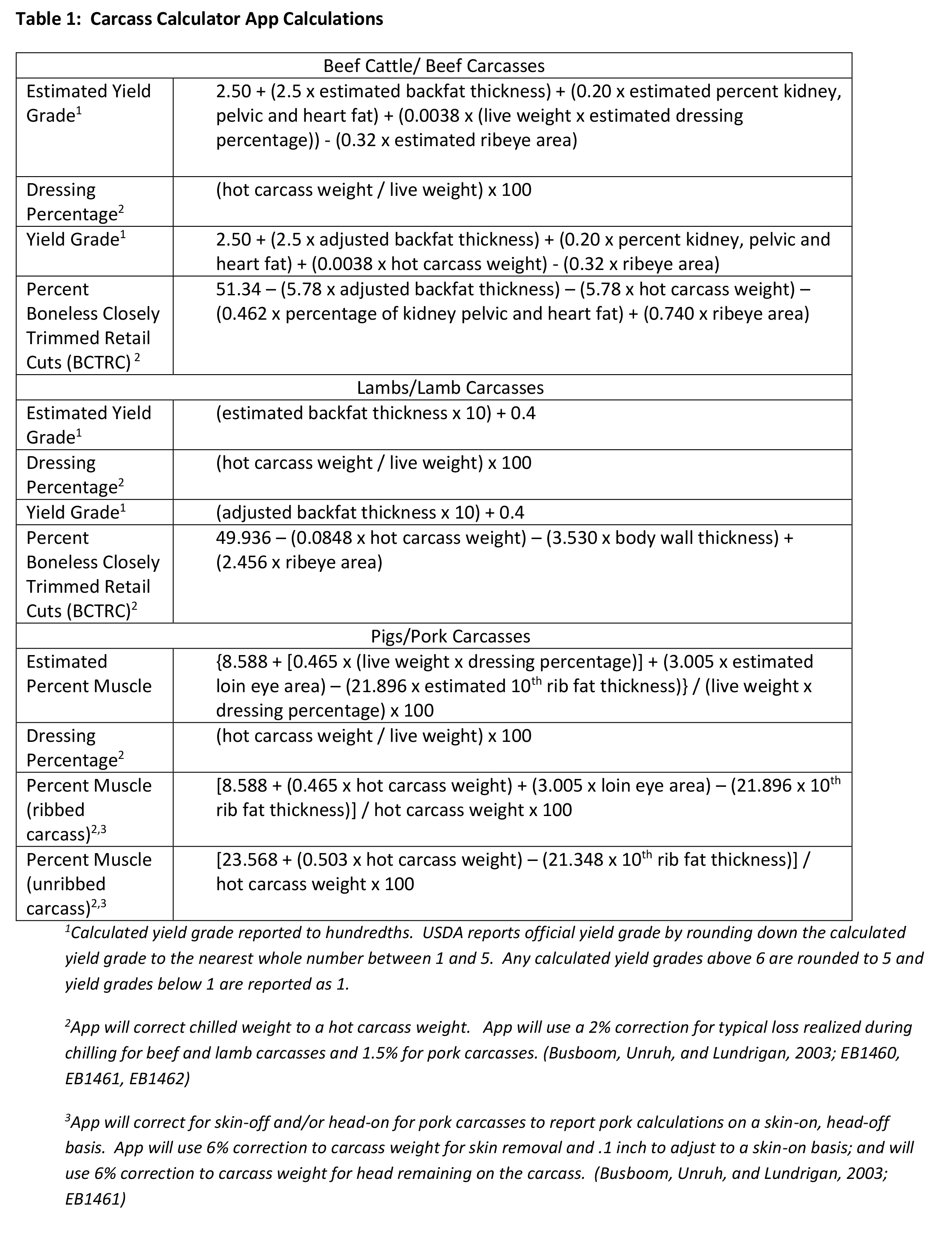
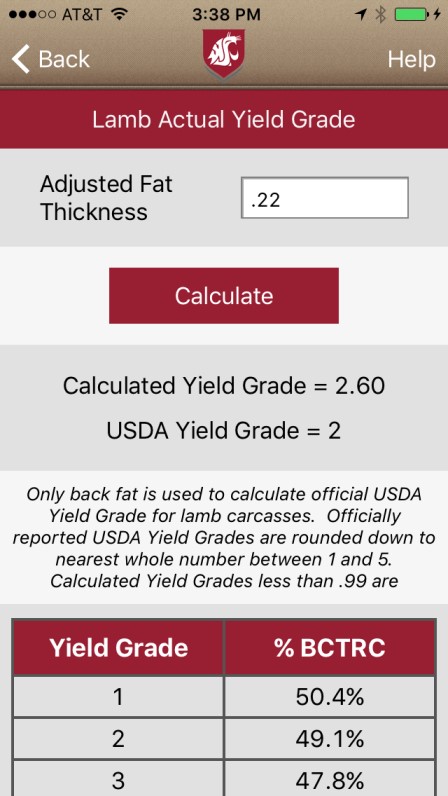
Figure 2. Calculated Yield Grade and USDA Yield Grade
Within the data entry section for each species and each equation, an expected range is highlighted in gray with the average for that specific carcass measurement identified in parentheses (Figure 3; Boggs et al., 2006). Each species section of the app has a “Help” section with equations and glossary definitions (Figure 4). All measures in the app are reported in U.S. weights and measurements.
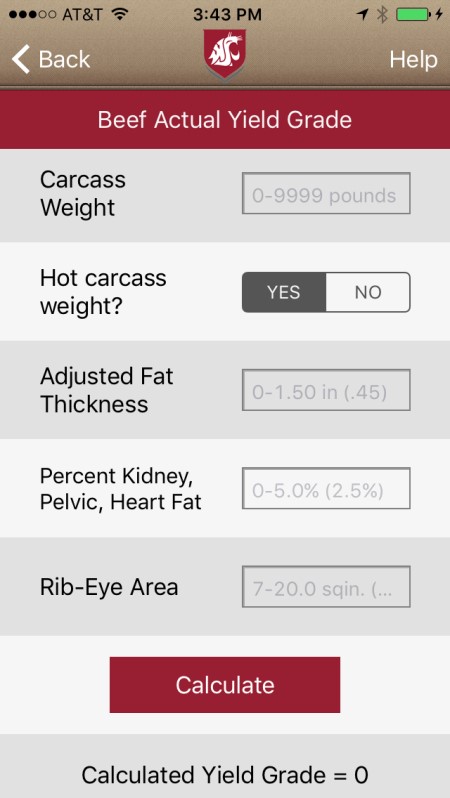
Figure 3. Expected Data Range and Industry Average Identified in Input Cells
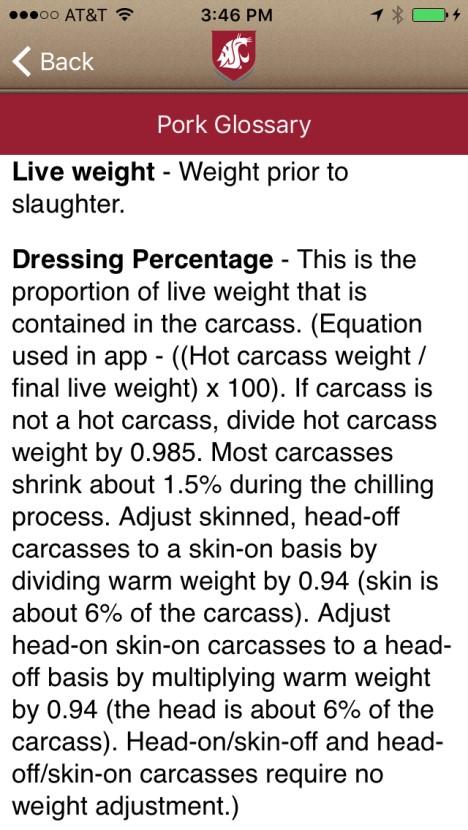
Figure 4. Individual Species Glossary Under Species Help Tab
Through the use of the WSU Livestock Carcass Grade & Cutability Calculator app, individuals can expand their understanding of factors that impact carcass merit and how they are calculated. Download of the Carcass Calculator App is available free for both Android and iOS platforms.
Use and Limitations
The Carcass Calculator App was released publicly in the summer of 2015. Use of the app has been promoted through news releases and use at WSU Meat Evaluation and Analysis (MEAT) Team and Extension programs. After approximately 18 months of download availability, the Android platform of the App was downloaded 360 and the iOS platform was downloaded 698 times, for a total 1058 total downloads. However, without direct user contact it is difficult to conduct impact evaluations to determine how users are using the app and if they have made production or management changes as a result of the information they received from using the app.
The accuracy of calculated carcass merit using this app or any computer/calculator is based on the accuracy of measurements entered. To increase accuracy in determining the dressing percentage, yield grade, and cutability, the user needs to have accurate measurements. A basic understanding of carcass evaluation will enhance the user’s ability to use the app. This tool is not meant to replace or verify USDA grades determined by USDA graders or grid pricing used to determine value of specific livestock or carcasses.
CONCLUSION
Complex algebraic equations are used to determine carcass merit, which are used in production and marketing of beef cattle, lambs, and pigs. The inaccurate use of carcass equations can negatively impact production by youth and commercial producers from misunderstanding the relationship and impact production decisions have on carcass merit and marketability (Schinckel and Rusk, 2012). The WSU Livestock Carcass Grade & Cutablity Calculator app is an easy and portable way for producers, niche marketers, butchers, livestock judges, meat evaluators, and youth to accurately and quickly determine the dressing percentage, yield grade, and cutability of beef, pork or lamb carcasses. As individuals use the app to determine carcass merit, they will learn how specific carcass factors positively or negatively influence the carcass merit, which in turn can be used to impact future decisions about animal selection, production, evaluation, sorting and marketing.
ACKNOWLEDGEMENTS
Development of this WSU Livestock Carcass Grade & Cutability Calculator App is funded in part by the Beginning Farmer and Rancher Development Program of the National Institute of Food and Agriculture, USDA Grant # 201-49400-19575.
WSU Livestock Carcass Grade & Cutability Calculator App authored by Sarah M. Smith and Jan R. Busboom, Washington State University Extension, as a project of the WSU Meat Evaluation and Analysis (MEAT) Team. App designed and developed by Not Without Us Interactive, LLC, Couer D’ Alene, ID.
Literature Cited
Boggs, D. L, Merkel, R.A., Doumit, M. E., and Bruns, K. (2006). Livestock & Carcass: An Integrated Approach to Evaluating, Grading, and Selection, 6th Ed. Kendall/Hunt Publishing Company. Dubuque, IA 52002.
Busboom, J. R., Unruh, J. A., and Lundrigan, R. (2003a). Washington Hog of Merit. Fact Sheet EB1461E. Washington State University Extension. Pullman.
Busboom, J. R., Unruh, J. A., and Lundrigan, R. (2003b). Washington Lamb of Merit. Fact Sheet EB1462E. Washington State University Extension. Pullman.
Busboom, J. R., Unruh, J. A., and Lundrigan, R. (2003c). Washington Steer of Merit. Fact Sheet EB1460E. Washington State University Extension. Pullman.
Dvorak, J. S., Franke-Dvorak, T.C., and Price, R. R. (2012). “Apps”—An Innovative Way to Share Extension Knowledge. Journal of Extension [On-line], 50(6), Article 6IAW2. Available at: https://joe.org/joe/2012december/iw2.php
Potter, B. (2015). 87% of Farmers Will Own a Smartphone by 2016. Retrieved from: http://www.agweb.com/article/87-of-farmers-will-own-a-smartphone-by-2016-naa-ben-potter/
Miar, Y., Plastow, G.S, Moore, S. S., Manafiazar, G., Charagu, P., Kemp, R. A., Van Haandel, B., Huisman, A. E., Zhang, C. Y. , Mckay, R. M., Bruce, H. L., and Wang, Z. (2014). Genetic and Phenotypic Parameters for Carcass and Meat Quality Traits in Commercial Crossbred Pigs. Journal of Animal Science, 92, 2869-2884. doi: 10.2525/jas2014-7685.
Mortimer, S. I., vander Werf, J. H. J., Jacob, R. H., Hopkins, D. L., Pannier, L., Pearce, K. L., Gardner, G. E., Warner, R. D., Geesink, G. H., Hocking-Edwards, J. E., Ponnampalam, E. N., Ball, A. J., Gilmore, A. R., and Pethick, D. W. (2014). Genetic Parameters for Meat Quality Traits of Australian Lamb Meat. Meat Science, 96, 1016-1024. doi: 10.1016/j.meatsci.2013.09.007.
Schinckel, A. P., and Rusk, C. P. (2012). The Need for Accurate Prediction Equations for the Carcass Lean Content of Pigs. Journal of Extension [On-line], 50(3), Article Number 3RIB5. Available at: https://joe.org/joe/2012june/rb5.php.
Utrera, A. R. and Van Vleck, L. D. (2004). Heritability Estimates for Carcass Traits of Cattle: A Review. Faculty Papers and Publications in Animal Sciences. Digital Commons@University of Nebraska-Lincoln. Paper 242. Retrieved from: http://digitalcommons.unl.edu/cgi/viewcontent.cgi?article=1251&context=animalscifacpub
